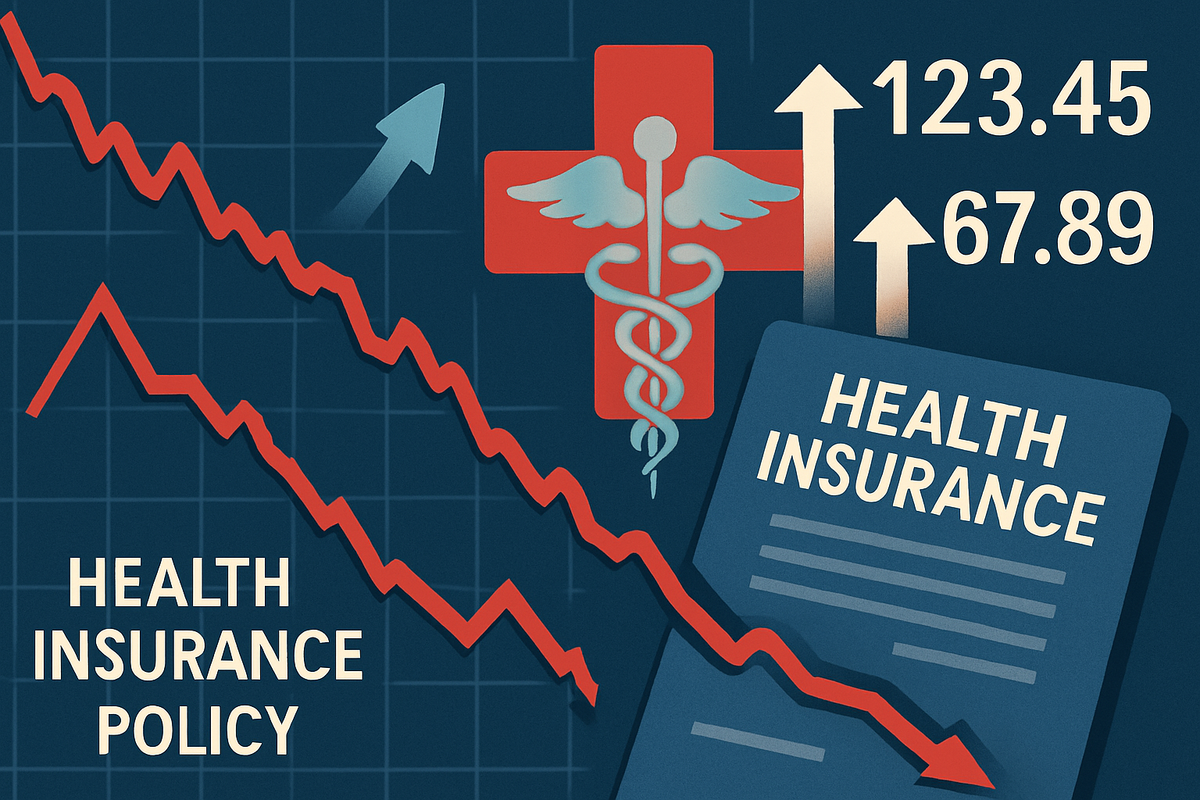
New York, NY – October 23, 2025 – The healthcare sector of the S&P 500 experienced a significant downturn today, conspicuously underperforming the broader market as a relentless surge in medical costs continues to erode the profitability of health insurers. This slump was epitomized by a dramatic sell-off in Molina Healthcare (NYSE: MOH) shares, which plummeted after the company revealed a substantial miss in its third-quarter earnings, largely attributed to higher-than-expected utilization and escalating healthcare expenses. The event signals a deepening crisis for the payer segment, raising concerns across the industry about future profitability and the sustainability of current premium structures.
The immediate implications are stark: investors are pulling back from health insurance stocks, fearing a prolonged period of margin compression. For consumers, the specter of higher premiums looms large, especially with the anticipated expiration of enhanced Affordable Care Act (ACA) subsidies. This single day's performance underscores a broader, multi-year trend where healthcare payers struggle to keep pace with an inflationary environment for medical services, setting the stage for potential industry-wide strategic shifts and regulatory scrutiny.
The Cost Conundrum: Molina Healthcare's Q3 Shocks the Market
Today's market activity saw the S&P 500 Healthcare sector, represented by the Health Care Select Sector SPDR ETF (XLV), remain flat or slightly negative, starkly contrasting with the S&P 500's modest gains of 0.6%. This underperformance is not an isolated incident but rather a continuation of a trend that has seen the sector trail the broader market by its widest margin in decades over the past two years, with a year-to-date return of -9.20%.
The most significant catalyst for today's decline was the staggering 17.5% plunge in Molina Healthcare (NYSE: MOH) shares, making it the worst-performing stock in the S&P 500. The dramatic fall followed the release of Molina's third-quarter 2025 earnings report, which painted a grim picture. The company reported adjusted earnings per share (EPS) of $1.84, a significant miss compared to analyst expectations ranging from $3.79 to $3.97. The core issue was a sharp increase in the consolidated medical care ratio (MCR), which surged to 92.6% in Q3 2025, up from 89.2% a year ago and notably higher than the consensus estimate of 90.3%. This critical metric indicates that Molina spent over 90 cents on medical care for every dollar of premium revenue collected.
Several factors contributed to Molina's elevated costs. The company cited higher-than-expected utilization of healthcare services by its enrollees, a trend that has accelerated throughout 2025. Its Affordable Care Act (ACA) Marketplace business was particularly hard hit, with its MCR skyrocketing to 95.6% from 73.0% in Q3 2024, accounting for roughly half of the company's overall underperformance. Specific areas of cost escalation included long-term supportive care services, an increase in expensive prescription drugs—including GLP-1s—and a rise in behavioral health services across its Medicaid, Medicare, and Marketplace segments. Consequently, Molina Healthcare has slashed its full-year 2025 adjusted EPS guidance to approximately $14 per share, a drastic reduction from its previous outlook of at least $19. This marks the third time this year the company has revised its annual profit forecast downward. The negative sentiment quickly spread, pulling down shares of other major health insurers, including Centene (NYSE: CNC), UnitedHealth (NYSE: UNH), Humana (NYSE: HUM), and Elevance Health (NYSE: ELV) on October 23, 2025.
Winners and Losers: A Shifting Landscape for Healthcare Players
The immediate fallout from the surge in medical costs creates a clear delineation between potential winners and losers within the healthcare ecosystem. Health insurers, particularly those with significant exposure to government-sponsored programs and ACA marketplaces, are currently positioned as the primary losers. Companies like Molina Healthcare (NYSE: MOH), with its heavy reliance on these segments, are directly grappling with the challenge of higher utilization and escalating treatment costs that outpace premium adjustments. The downward revisions in earnings guidance and the sharp decline in stock prices for Molina and its peers such as Centene (NYSE: CNC), Humana (NYSE: HUM), UnitedHealth (NYSE: UNH), and Elevance Health (NYSE: ELV) underscore the immense pressure on their profitability. These companies face the arduous task of re-evaluating their risk models, negotiating more favorable rates with providers, and implementing stricter cost-containment measures to restore their medical loss ratios to sustainable levels.
Conversely, certain segments of the healthcare industry might find themselves in a relatively advantageous position, or at least less impacted. Healthcare providers, such as hospitals and pharmaceutical companies, while facing their own cost pressures, are the recipients of the increased utilization and higher drug prices that are burdening insurers. While they may face tougher negotiations from payers, the fundamental demand for their services remains robust. Additionally, companies involved in healthcare technology and data analytics that can offer solutions for cost management, efficiency, and fraud detection could see increased demand for their services. Firms specializing in value-based care models or those that can demonstrate tangible cost savings for insurers might also emerge as strategic partners. However, the overall deflationary pressure from insurers could eventually trickle down to providers, making sustained "winning" difficult in a truly interconnected system.
The long-term outlook for health insurers will hinge on their ability to accurately forecast and price for these rising costs, as well as their success in managing member utilization through care coordination and preventative programs. Those with diversified portfolios, strong balance sheets, and innovative approaches to cost management may weather the storm more effectively. However, the current environment necessitates a cautious approach for investors in the payer segment, as the battle against rising medical expenses is far from over.
Wider Significance: Industry Trends and Regulatory Headwinds
The underperformance of the healthcare sector, particularly among health insurers, is not merely a transient market event but rather a symptom of deeper, structural shifts within the U.S. healthcare landscape. This current crisis fits squarely into broader industry trends marked by an aging population, the increasing prevalence of chronic diseases, the development of expensive new therapies (like GLP-1s for weight loss and diabetes), and persistent inflationary pressures on medical services. The escalating medical care ratio reported by Molina Healthcare (NYSE: MOH) is a bellwether, signaling that the traditional model of premium collection versus claims payout is under severe stress across the entire payer segment. This trend could accelerate the shift towards more integrated care models, where insurers and providers share risk and collaborate more closely on patient outcomes and cost management.
The ripple effects of this situation are far-reaching. Competitors of Molina, such as Centene (NYSE: CNC) and Humana (NYSE: HUM), which also have substantial exposure to government programs, are likely to face similar pressures and increased scrutiny from investors. The negative sentiment could also impact healthcare technology companies and pharmacy benefit managers (PBMs) as insurers seek to renegotiate contracts and demand greater cost efficiencies. Furthermore, the situation has significant regulatory and policy implications. The anticipated expiration of enhanced premium tax credits for the ACA at the end of 2025, coupled with rising medical costs, could lead to substantial premium increases for individuals. This could reignite political debates around healthcare affordability, potentially leading to new legislative efforts to control drug prices, regulate insurer practices, or even expand government-funded healthcare options. The future of Medicaid funding, especially given state budget pressures, also remains a critical area of policy uncertainty.
Historically, the healthcare sector has often been considered a defensive play during economic downturns due to its essential nature. However, the current environment suggests that even this traditionally stable sector is vulnerable to unique cost pressures and regulatory shifts. Comparisons can be drawn to periods in the past where significant medical inflation or changes in healthcare policy led to volatility and consolidation within the insurance industry. The current situation, however, appears to be driven by a confluence of factors – demographic shifts, technological advancements (leading to expensive new treatments), and a post-pandemic surge in utilization – making it a particularly complex challenge for market participants.
What Comes Next: Navigating a Volatile Landscape
The coming months and years will be critical for the healthcare sector, particularly for health insurers grappling with the persistent challenge of rising medical costs. In the short term, investors should anticipate continued volatility in the stock prices of health insurers, especially as companies release future earnings reports and provide updated guidance. Further downward revisions to profit forecasts are possible if utilization trends and cost inflation do not abate. Insurers will likely respond by intensifying their efforts to negotiate lower rates with providers, implement more stringent prior authorization protocols, and explore innovative care management programs to curb unnecessary spending. For consumers, the immediate future likely entails higher premium increases for 2026, especially for those in the ACA marketplace, if enhanced subsidies are not extended.
In the long term, this crisis could catalyze significant strategic pivots across the industry. Health insurers may increasingly look to diversify their revenue streams beyond traditional underwriting, potentially through ventures into healthcare services, technology, or even direct-to-consumer offerings that focus on preventative care and chronic disease management. Mergers and acquisitions could accelerate as companies seek economies of scale, greater market power in negotiations, or access to new technologies that promise cost efficiencies. The emphasis on value-based care, where providers are reimbursed based on patient outcomes rather than volume of services, is likely to gain further traction as insurers push for greater accountability in spending.
Market opportunities may emerge for companies that can offer genuinely disruptive solutions for cost containment, such as AI-powered diagnostics, remote patient monitoring platforms, or advanced analytics that predict and manage high-cost claimants. Conversely, challenges will persist for smaller, less diversified insurers or those unable to adapt quickly to the evolving cost landscape. Potential scenarios range from a stabilization of medical costs through aggressive industry actions and policy interventions, to a continued upward spiral that fundamentally reshapes the insurance market, potentially leading to further consolidation or increased government intervention to ensure access and affordability. Investors should closely monitor regulatory developments, particularly regarding ACA subsidies and potential new cost-control legislation, as well as the quarterly earnings reports of major payers for insights into utilization trends and MCRs.
Comprehensive Wrap-Up: A Sector at a Crossroads
Today's sharp underperformance of the S&P 500 Healthcare sector, underscored by Molina Healthcare's (NYSE: MOH) significant earnings miss and stock plunge, serves as a potent reminder of the profound challenges facing the health insurance industry. The key takeaway is clear: rising medical costs, driven by increased utilization, expensive new therapies, and inflationary pressures, are not a transient issue but a systemic threat to the profitability of healthcare payers. Molina's surging medical care ratio (MCR) to 92.6% is a stark indicator of the unsustainable economics currently at play, forcing the company to cut its full-year guidance for the third time this year and sending ripple effects across the sector to peers like Centene (NYSE: CNC), UnitedHealth (NYSE: UNH), Humana (NYSE: HUM), and Elevance Health (NYSE: ELV).
Moving forward, the market will likely remain highly sensitive to any news regarding medical cost trends and insurer profitability. The current environment necessitates a recalibration of investor expectations for the healthcare payer segment. While the sector's long-term fundamentals tied to demographic shifts remain strong, the immediate future demands a focus on operational efficiency, aggressive cost management, and potentially innovative business models. The anticipated expiration of enhanced ACA subsidies adds another layer of complexity, threatening to further exacerbate premium increases for consumers and intensify political pressure on the industry.
The lasting impact of this event could be a more consolidated and technologically advanced health insurance industry, driven by the imperative to control costs and deliver value. Companies that can effectively leverage data, embrace value-based care models, and navigate the intricate regulatory landscape will be best positioned to thrive. Investors should watch for several key indicators in the coming months: the MCRs of major health insurers, commentary on future utilization trends, proposed premium increases for 2026, and any legislative developments regarding healthcare policy and subsidies. The healthcare sector is at a crossroads, and how it responds to these escalating cost pressures will define its trajectory for years to come.
This content is intended for informational purposes only and is not financial advice





